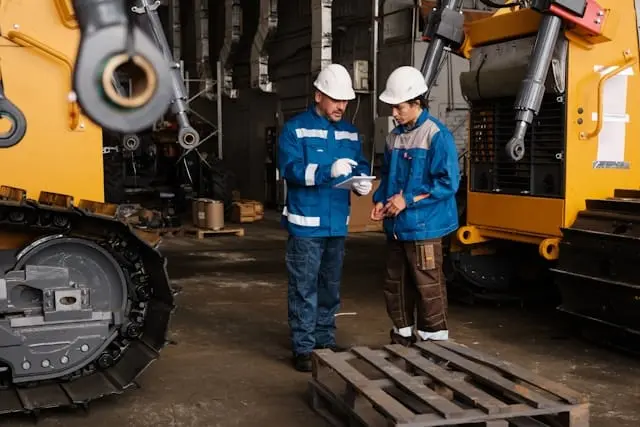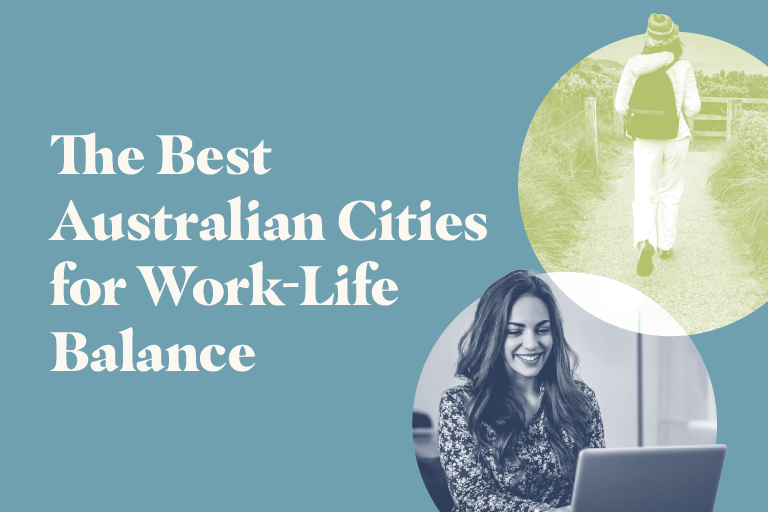
The Best Australian Cities for Work-Life Balance
Australia is one of the most popular places for people to relocate, with the 9th highest number of foreign residents, according to the United Nations1. The high number of overseas residents is due to its high quality of life, diverse culture, and strong economy. According to the Australian Bureau of Statistics, almost 8.6 million people have moved down under, which equates to over 30% of its population, as of June 20242.
This is the highest it’s ever been, and the number of Australian residents being born elsewhere has increased each year since 2000, when 23% of Australia’s population was born overseas, as stated by the Australian Bureau of Statistics.
Some people move for a working holiday under the Working Holiday Maker program, while others make long-term relocations to start new lives down under. Whatever their reason, balancing work with time to explore is part of the appeal.
Not only is Australia a great place to travel, but it’s also bursting with work opportunities. This is ideal if you’re looking to emigrate and build a career abroad to send money from Australia to your loved ones. Its work-life balance is also a key factor in people moving down under.
But which cities have the best work-life balance? To find out, we’ve looked into commute times, internet speed, rent prices, salaries, weather and weekly working hours in various Australian cities. We’ve also looked into the number of beaches, cafes, and nature and wildlife areas to see which cities have the most things to offer in your free time.
This is the highest it’s ever been, and the number of Australian residents being born elsewhere has increased each year since 2000, when 23% of Australia’s population was born overseas, as stated by the Australian Bureau of Statistics.
Some people move for a working holiday under the Working Holiday Maker program, while others make long-term relocations to start new lives down under. Whatever their reason, balancing work with time to explore is part of the appeal.
Not only is Australia a great place to travel, but it’s also bursting with work opportunities. This is ideal if you’re looking to emigrate and build a career abroad to send money from Australia to your loved ones. Its work-life balance is also a key factor in people moving down under.
But which cities have the best work-life balance? To find out, we’ve looked into commute times, internet speed, rent prices, salaries, weather and weekly working hours in various Australian cities. We’ve also looked into the number of beaches, cafes, and nature and wildlife areas to see which cities have the most things to offer in your free time.
Key findings:
- Smaller regional cities offer the best work-life balance across Australia, with the likes of Mackay, Ballarat, and Hobart taking the top three positions nationwide.
- Data shows that those in Launceston, Tasmania, have the shortest average commute in Australia, at 13.33 minutes.
- Analysis of Australian Bureau of Statistics data reveals that Tasmanians work the shortest weeks at 32.8 hours worked per week, on average.
What does a work-life balance mean?
A good work-life balance means giving fair time and attention to both your job and your life outside of it. According to the Mental Health Foundation, it's not about splitting your time 50/50 between work and leisure but about managing your time in a way that keeps work, rest, and personal responsibilities in check. Getting this balance right can help reduce stress, improve your mental health, and protect against burnout.
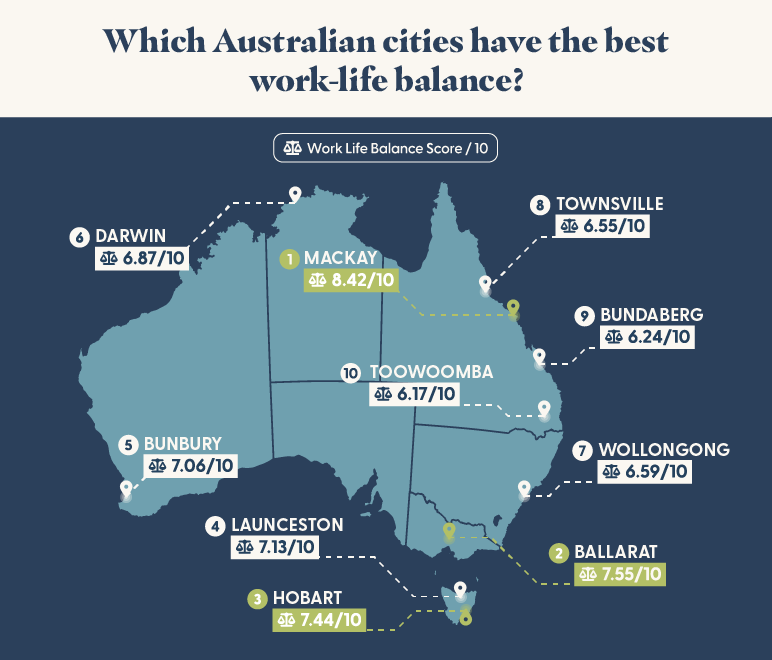
Which Australian cities have the best work-life balance?
From our research, we found that typically, smaller cities appear to offer a better work-life balance due to their slower pace of life, strong community, and lower cost of living. So, which of Australia’s cities offers the best work-life balance?

- Mackay, Queensland: 8.42 work-life balance score
Mackay takes the top spot, with a work-life balance score of 8.42 out of 10. Mackay has the most beaches listed on travel review websites, with just over 14 per 100,000 people. This, paired with an average annual temperature of 23°C, means you’ll have plenty of opportunities throughout the year to enjoy the variety of beaches in Mackay. This city is also known for its seafood and tropical produce, and the Mackay Festival of Arts, which happens every year across July.
Not only do employees in Mackay have an average monthly salary of $7,944 after tax, but rent prices are lower than most cities on our analysis, meaning you’ll have plenty of disposable income to spend on your hobbies.
Mackay’s social and welcoming community also means you won’t have trouble making friends and fitting in. Due to its small size, your commute time will be lower than in other places, giving you more time to do the things you love.
Not only do employees in Mackay have an average monthly salary of $7,944 after tax, but rent prices are lower than most cities on our analysis, meaning you’ll have plenty of disposable income to spend on your hobbies.
Mackay’s social and welcoming community also means you won’t have trouble making friends and fitting in. Due to its small size, your commute time will be lower than in other places, giving you more time to do the things you love.
- Ballarat, Victoria: 7.55 work-life balance score
In second place is Ballarat, with a work-life balance score of 7.55 out of 10. Affordable living, a relaxing lifestyle, and a strong community feel are all at the heart of what makes this city in Victoria so great.
Ballarat has one of the lowest rent prices on our list, with the average rent costing $1,310 per month. Ballarat also ranks highly for its download speed, cafes, and nature and wildlife areas, making it a great place to enjoy downtime.
Ballarat offers many career opportunities, with several businesses headquartered here, including McCain Foods, Alstom, and Mars Wrigley Confectionery. Due to its small size, travelling to work doesn’t take too long. This balance of strong job prospects and short commute times means its residents can pursue their careers while having time to spend with families and take up hobbies.
Ballarat is known for its unique and well-preserved ancient architecture. From town halls to art galleries, you are never too far from some beautiful architecture in Ballarat. It's also the home of the oldest regional art gallery in Australia, the Art Gallery of Ballarat, contributing to Ballarat's vibrant arts and culture scene.
Ballarat has one of the lowest rent prices on our list, with the average rent costing $1,310 per month. Ballarat also ranks highly for its download speed, cafes, and nature and wildlife areas, making it a great place to enjoy downtime.
Ballarat offers many career opportunities, with several businesses headquartered here, including McCain Foods, Alstom, and Mars Wrigley Confectionery. Due to its small size, travelling to work doesn’t take too long. This balance of strong job prospects and short commute times means its residents can pursue their careers while having time to spend with families and take up hobbies.
Ballarat is known for its unique and well-preserved ancient architecture. From town halls to art galleries, you are never too far from some beautiful architecture in Ballarat. It's also the home of the oldest regional art gallery in Australia, the Art Gallery of Ballarat, contributing to Ballarat's vibrant arts and culture scene.
- Hobart, Tasmania: 7.44 work-life balance score
Completing our top three is Hobart, with a work-life balance score of 7.44 out of 10. Thanks to its beautiful surroundings, Hobart is known for being a gateway to nature. Stunning national parks, beaches, and wilderness areas are easily accessible to Hobart’s residents, as shown by the 30 nature and wildlife areas per 100,000 people, the highest on our list.
This Tasmanian city also has one of the lowest average weekly working hours, with its residents working 32.8 hours, giving you plenty of opportunities to wind down and enjoy your hobbies.
The second-oldest city in Australia is also known for its slow pace of life, strong sense of community, and focus on well-being. The Department of State Growth offers several leave options, such as annual leave, sick leave, and maternity leave, to support a healthy work-life balance.
This Tasmanian city also has one of the lowest average weekly working hours, with its residents working 32.8 hours, giving you plenty of opportunities to wind down and enjoy your hobbies.
The second-oldest city in Australia is also known for its slow pace of life, strong sense of community, and focus on well-being. The Department of State Growth offers several leave options, such as annual leave, sick leave, and maternity leave, to support a healthy work-life balance.
The city with the quickest average commute
Launceston, Tasmania: 13.33 minutes average one-way commute time
Launceston’s residents get to work the quickest on average, with the average commute taking just 13 minutes. Having a quick commute is a great way to improve your work-life balance. It means you can spend more time with your loved ones, enjoying your hobbies, and doing the things that help you unwind from work.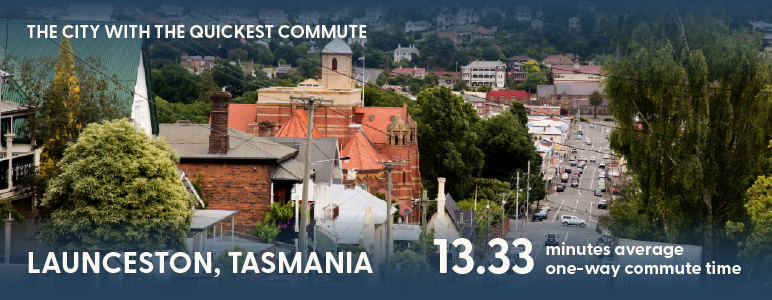
The city with the fastest internet
Ballarat, Victoria: 44.8 Mbps average download speed
Rockhampton has the fastest internet speed, with an average download speed of 44.8 Mbps. This city in Victoria also has an upload speed of 11.1 Mbps, proving why Ballarat is the best city for staying connected with your colleagues and friends around the world.The city with the cheapest rent
Bendigo, Victoria: $975 average monthly rent
If you’re looking for cheap rent, Bendigo is the best Australian city for you, with an average rent of $975 per month. Bendigo’s rental market is slower than many other cities, thanks to its high supply of properties. The cost of living in this city is also lower than most, making this a great place to live if you are sticking to a tighter budget.The city with the most registered beaches
Mackay, Queensland: 14.82 beaches per 100,000 people
One of the best ways to relax and unwind after a long week is by going to the beach with family or friends. Mackay is one of the best places to do this if you’re looking for fewer crowds, with almost 15 beaches per 100,000 people registered on travel review websites. Blacks Beach is the longest in Mackay, stretching over six kilometres. No matter which beach you choose, you’re never far away from golden sand, inviting waters, and picturesque scenery.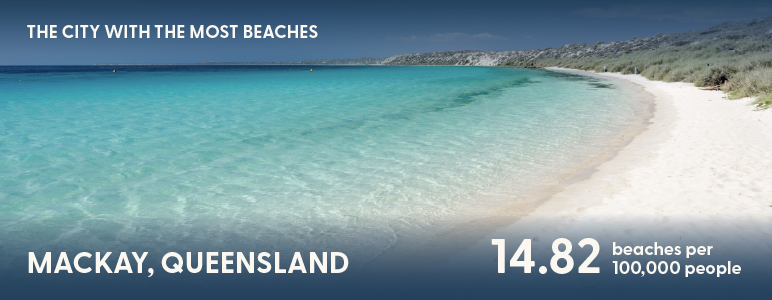
The city with the highest average earners
Mackay, Queensland: $7,944 average monthly salary after tax
It may come as a surprise that Mackay residents on average earn more than those in Sydney, with the Queensland city’s locals earning an average post-tax salary of $7,944 per month. Mackay is one of the largest sugar-producing cities in Australia, producing almost 30% of the country's sugarcane crops, and is also a key hub for mining and resources, needing several high-skilled workers in potentially higher-paying and dangerous associated engineering and manufacturing jobs.The hardest-working city
Mackay, Queensland: Australia’s hardest working city?
Mackay ranked highly in Australia for its “direct work factors” by a report analysing the hardest-working cities in Australia.This ranking is based on metrics such as average weekly working hours, employment and unemployment rates, the proportion of unused annual leave, and idle youth rates, using data sourced from the Australia Census Bureau, ABS Survey of Education and Work, Volunteering Australia, and other public datasets. More information on this report can be found in the list of sources.
The city with the most cafes
Hervey Bay, Queensland: 91.9 cafes per 100,000 people
Having a wide range of cafes to choose from is great for getting your morning coffee, treating yourself to something sweet, and having an alternative place to work. Hervey Bay has the most, with 91.9 per 100,000 people. Having a lot of cafes to explore can also reduce waiting times, which is great if you’re running late to work.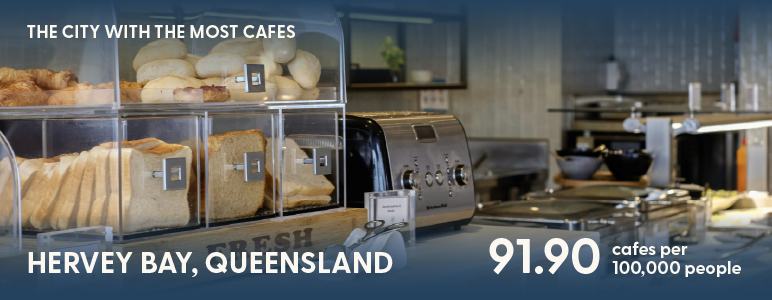
The hottest city
Darwin, Northern Territory: 27.4°C average temperature
Darwin has the hottest temperatures, with an average temperature of 27.4°C. Warm weather is great for unwinding and destressing, as it means you can get outside and enjoy your hobbies. Vitamin D, produced by the body through sun exposure, is also great for improving your mood. Despite having a rainy season from December to March, the temperature in Darwin is consistently warm. In the coldest month of the year, July, the temperature is 25.2°C.The city with the best access to nature
Hobart, Tasmania: 30.46 nature and wildlife areas per 100,000 people
Hobart is the best place to connect with nature, with 30.46 nature and wildlife areas registered online per 100,000 people. Hobart is rich in wildlife sanctuaries, nature reserves, and picturesque hiking trails, so there’s bound to be even more hidden gems available. If you’re looking to appreciate the vast wildlife in Hobart, then some of the top picks include Waterworks Reserve, Kunanyi, and Mount Wellington.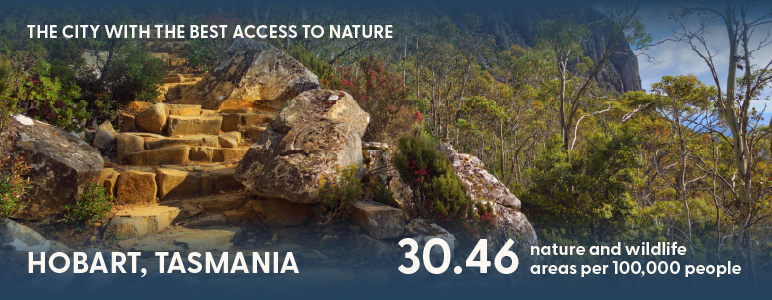
The state with the lowest working hours
Tasmania: 32.8 average working hours
Tasmanians work the fewest hours in a week, with people working an average of 32.8 hours, the equivalent of 131 hours per month, making a good work-life balance far easier to achieve than in mainland Australia. Needless to say, this can reduce the chance of burnout, and it gives you more time to spend with your friends and family and enjoy your hobbies.The city with the cheapest coworking spaces
Hobart, Tasmania: $250 monthly cost of coworking space
If you’re someone who works from home, then having a range of affordable coworking spaces is really important. Whether you want to improve your focus or fancy a change of scenery from time to time, Hobart is a great place, with a hotdesk in a coworking space costing an average of $250 a month.
How to achieve a healthy work-life balance
Achieving the perfect balance between your professional and personal life isn’t easy, but there are steps you can take to help you get there.
Prioritise your personal well-being
Make space in your schedule for hobbies and downtime. You can join a local sports team, get outdoors, or pick up something creative; these activities can help you switch off from work, stay active, and boost your mental health. Social hobbies, in particular, are a great way to meet new people and build a support network outside of your job.
Make time for family and friends
Spending time with the people who matter (whether that’s family, close friends, or both) is a key part of a healthy work-life balance. It’s not just about being present, but about showing your loved ones that they’re a priority outside of work. Making time for shared experiences, conversations, and memories can strengthen relationships, reduce stress, and help you feel more grounded when work gets busy.
Find ways to relax
Even for people who love their job, the responsibilities and expectations that come with their work can cause stress and frustration. Find ways to relax to help manage your stress. It’s very easy to bring these emotions home and end up causing friction with loved ones, so finding ways to manage your stress can improve your home life
Prioritise your sleep
Sleep is vital to maintaining a work-life balance. It can help improve productivity and mood, reduce stress, and improve physical and mental health. Prioritising your sleep can be hard, but aiming for at least seven to eight hours of sleep a night can help you in all aspects of your life.
Prioritise your personal well-being
Make space in your schedule for hobbies and downtime. You can join a local sports team, get outdoors, or pick up something creative; these activities can help you switch off from work, stay active, and boost your mental health. Social hobbies, in particular, are a great way to meet new people and build a support network outside of your job.
Make time for family and friends
Spending time with the people who matter (whether that’s family, close friends, or both) is a key part of a healthy work-life balance. It’s not just about being present, but about showing your loved ones that they’re a priority outside of work. Making time for shared experiences, conversations, and memories can strengthen relationships, reduce stress, and help you feel more grounded when work gets busy.
Find ways to relax
Even for people who love their job, the responsibilities and expectations that come with their work can cause stress and frustration. Find ways to relax to help manage your stress. It’s very easy to bring these emotions home and end up causing friction with loved ones, so finding ways to manage your stress can improve your home life
Prioritise your sleep
Sleep is vital to maintaining a work-life balance. It can help improve productivity and mood, reduce stress, and improve physical and mental health. Prioritising your sleep can be hard, but aiming for at least seven to eight hours of sleep a night can help you in all aspects of your life.
Why is work-life balance important?
It’s widely recognised that staying happy, healthy, and fulfilled in all areas of life is important, but here’s a more detailed breakdown of exactly why you can benefit from prioritising work-life balance.
1. Improved productivity
Employees who have a healthy work-life balance are more engaged and focused at work. Having things to look forward to, whether that is a holiday in a couple of weeks or months or a hobby after your working day has finished, can also help improve your productivity.
2. Improved physical and mental health
Having hobbies and interests outside of work is great for your mental health and a fantastic way of escaping the stresses of your job. Finding something that gets you outside with others can be a great way to socialise and get some sun. Being in the sun can increase your body’s vitamin D production, which, according to the National Institutes of Health, can lower cortisol levels.
3. Improved morale and motivation
Feeling valued at work and at home can lead to increased job satisfaction, which can improve your overall mood and desire at work.
4. Reduced chance of burnout
Burning out at work can have a spiralling effect on your home life and career. By putting time aside to relax and destress, you can significantly reduce the chance of exhaustion.
1. Improved productivity
Employees who have a healthy work-life balance are more engaged and focused at work. Having things to look forward to, whether that is a holiday in a couple of weeks or months or a hobby after your working day has finished, can also help improve your productivity.
2. Improved physical and mental health
Having hobbies and interests outside of work is great for your mental health and a fantastic way of escaping the stresses of your job. Finding something that gets you outside with others can be a great way to socialise and get some sun. Being in the sun can increase your body’s vitamin D production, which, according to the National Institutes of Health, can lower cortisol levels.
3. Improved morale and motivation
Feeling valued at work and at home can lead to increased job satisfaction, which can improve your overall mood and desire at work.
4. Reduced chance of burnout
Burning out at work can have a spiralling effect on your home life and career. By putting time aside to relax and destress, you can significantly reduce the chance of exhaustion.
Methodology
Remitly is an online remittance service operating globally, enabling users to transfer money digitally in approximately 100 currencies to 170 countries, with people trusting the platform to send money quickly and securely to loved ones around the world. With Australia being a popular destination among workers looking to move abroad, we uncovered the best cities for work-life balance by analysing the following data:
We put this data into a weighted table, giving each factor a normalised score out of 10. We then took an average of these scores to get our overall work-life balance scores out of 10. We then added 1 to each of these scores to get our final work-life balance scores.
Finally, we used Coworking Cafe to find the number of coworking spaces in each city. This was not included in our overall work-life balance rankings.
All data is accurate as of 14th July 2025.
- We used Numbeo data, which is based on user-contributed survey data, to find the average one-way commute in minutes. This data represents the average one-way daily commute time required in minutes reported by locals.
- We also used Numbeo to get the average monthly rent price. This data represents the cost of a one-bedroom apartment in the city centre.
- We used Numbeo again to get the average monthly salary after tax.
- We used Test My to find the average download speed (Mbps).
- We used online tourist reviews to find the number of cafes and nature, and wildlife areas in each city. We then normalised this data to calculate the number per 100,000 people.
- We used Climate Data to find the average temperature in each city.
- We used Snow Season Central’s analysis to find each city's 'Direct Work Factors Rank' number in the 'Hardest-Working Cities in Australia' table. Ranking is based on cities' average workweek hours, employment rate, unemployment rate, share of workers leaving vacation time unused, and idle youth.
- We used the Australian Bureau of Statistics to find the total monthly hours worked in each state. We also took the number of employed people in each state to work out the average hours worked per person per month. This figure was divided by four to get the average hours worked per week.
We put this data into a weighted table, giving each factor a normalised score out of 10. We then took an average of these scores to get our overall work-life balance scores out of 10. We then added 1 to each of these scores to get our final work-life balance scores.
Finally, we used Coworking Cafe to find the number of coworking spaces in each city. This was not included in our overall work-life balance rankings.
All data is accurate as of 14th July 2025.
Sources
- United Nations, International Migrant Stock https://www.un.org/development/desa/pd/content/international-migrant-stock
- Australian Bureau of Statistics, Australia's population by country of birth https://www.abs.gov.au/statistics/people/population/australias-population-country-birth/jun-2024#data-downloads
